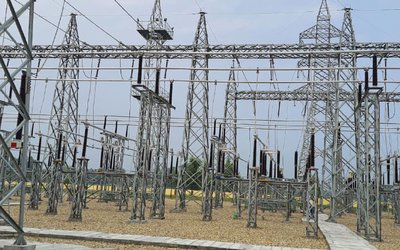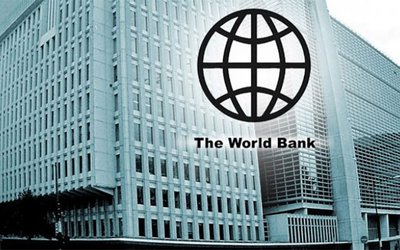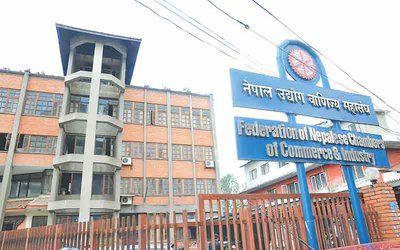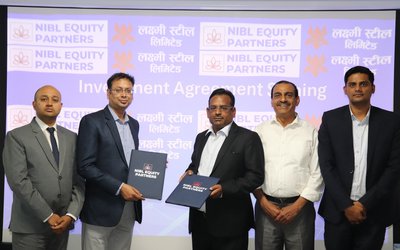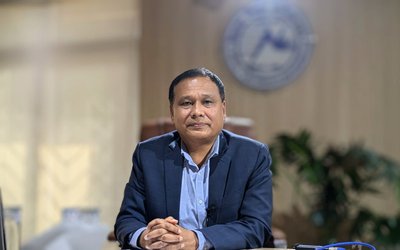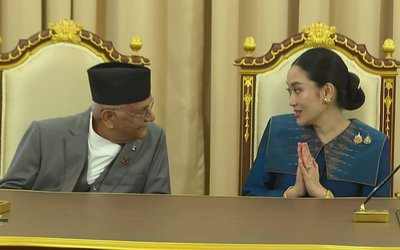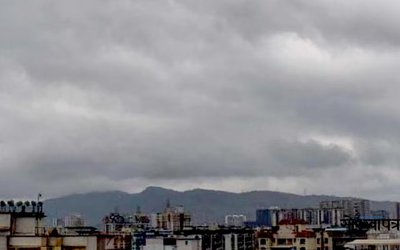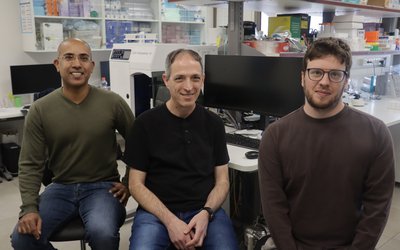
Out of the total budget allocated under the capital expenditure, the government has been able to use just over 40 percent, compared to nearly sixty percent of recurrent expenditure. As the government failed to spend the allocated budget in the capital expenditure, there is surplus of 60 billion rupees.
Thus, the government has just borrowed a small amount of money internally. “This is lowest borrowing in nine years. As the government has surplus money in its account, it is unlikely to borrow more money in this fiscal year,” said an official at the Ministry of Finance.
Nepal Rastra Bank reveals that there is Rs. 60 billion surplus money in the government account. “As there is a big deposit in the government account, the government did not mobilize internal loan this year,” said Nara Bahadur officiating director of Loan Management Division of Nepal Rastra Bank.
“Although the capital expenditure has increased at the final quarter of the budget, the government does not need to borrow money from internal sources,” said an official at the Ministry of Finance.
Nepal’s capacity to spend money is limited. Although Nepal can use up to US$ 200 million annually from the funds of World Bank and Asian Development Bank, the government has used below 30 million dollars in current fiscal year from each bank. In terms of the utilization of grant money provided by the donor countries, Nepal has utilized just over 30 percent.
“Due to prolonged political instability with partial budgets and CA elections, Nepal's capacity to use the money had reduced. It is likely to increase in the coming year as the country has an elected government with a stable policy now,” said Joint Secretary and head of International Economic Cooperation Coordination Division of Ministry of Finance.
As Nepal has announced its initiative to graduate from Least Developed Country to a developing country by 2022, it needs to invest a huge amount of resources in the social and infrastructure sectors. Nepal’s target to achieve 8 percent of annual GDP is unlikely at the present rate of capital expenditure.
“As there is a stable and elected government, the government needs to take certain drastic steps to enhance the efficiency of the government agencies to increase the capital expenditure,” said Dr. Rabindra Kumar Shakya, former vice chairman of National Planning Commission. “The current level of capital expenditure will take Nepal nowhere in future.”
New Projects
In the history of Nepal, this is a good time to make major breakthroughs in the development sector as there is surplus of resources. Although Nepal’s current level of trade deficit is high, equivalent to the flow of remittances, Nepal can make a difference by investing the money in development infrastructure.
Giving continuity to the national pride projects, the present government also made commitment to carry on with the 21 National Pride Projects. The government, through its annual program, even expressed its priority to take up the projects like Kathmandu-Madheh-Terai Fast Track. The policy also proposes the expansion of Tribhuwan International Airport, construction of Gautam Buddha International Airport in Lumbini and Regional Airport from this year. Similarly, the government also announced the push for construction of Nijgar International Airport.
Building four major airports within 20 aeronautical miles is another flaw in development. For balanced development, one airport should have in eastern Nepal or far western Nepal instead of at Nijgarh.
As there is surplus money, the government has proposed to carry out the construction of Mid-hill highway, Hulaki highway and other north south highways. As Nepal has been starving from the lack of energy, the government has also announced its aim to carry out the detailed project study of storage hydro power projects like Naumure, NalsinghGad, Uttar Ganga, Budhi Gandaki and Andhikhola.
The government has announced plan to commence the construction of Budhi Gandaki storage hydro electric project. Development of 10 urban centers along the Mid-hill Pushpa Lal high way is another priority.
The government has declared that the construction of 400 KV transmission line between Nepal India (Majafarpur and Dhalkebar) will also be started. Similarly, the government has also made the commitment to complete Sikta Irrigation project, Ranijamara Kuleria Irrigation project and Bheri Diversion project to increase the irrigated land in mid-west.
Accelerating the construction of Melamchi Drinking water project is in the priority list of the government. The government is pushing the programs in its annual program.
Fate of Priority Projects
Although the government of Nepal accorded high priority to 21 pride infrastructure projects, the budget's total allocation for these projects was merely 4.22 percent of total budget and 25.67 percent of development expenditure.
As the budget allocation is dismal, the rate of utilization of the budget by these projects is very low. At the 32nd National Planning Commission’s National Development Problems Settlement Committee Meeting in May, member secretary of National Planning Commission Dr. Som Lal Subedi presented a very bleak scenario.
According to his presentation, out of 21, only two projects were able to exceed the 50 percent of the budget target allocated to them. Even the project like Melamchi is unable to use 20 percent of the allocated budget.
Recurrent Vs Capital
Out of total budget proposed in the year 2070/071 in recurrent account, the government spent just 55.63 recurrent expenditure and 30.86 under capital expenditure and 24.06 in finance. The total budget spent till March was just 46.75 percent.
However, the expenditure has increased after March. According to the Financial Comptroller General Office, the government has spent Rs. 38,49,09,057 000.00 or 74.42 percent by July 7, 2014. It includes 28,27,68,902 000.00 or 80.01 percent in recurrent and 4,70,40,006000.00 or 55.28 percent in capital expenditure and 5,51,00,148000.00 or 69.99 percent in finance.
Despite the increase in the volume of spending of capital expenditure, the Financial Comptroller General Office report shows that Nepal’s capital expenditure is still low compared to recurrent expenditure.
Except the Ministry of Defense and Commission of Investigation of Abuse of Authority, no other ministries are able to spend the capital expenditure allocated to them.
Donors Views
Nepal’s leading multilateral agencies, the World Bank and Asian Development Bank, see the current trend with cautious optimism given the country’s fragile political scenario.
“The enabling environment for development has improved but opportunities need to be effectively leveraged through focused policy. The successful election of a new parliament and subsequent formation of a popularly mandated government provide a more conducive environment for private sector activity and economic policy,” says the World Bank’s Nepal Economic Update April 2014.
“Nepal has significant resources in the form of remittances from abroad but the economy cannot use these resources in a productive manner to enhance the overall welfare of all citizens.”
Similarly, an Asian Development Bank Report also looks at the situation with optimism. The economic outlook is more optimistic now than in FY2013, considering the successful second Constituent Assembly election in November 2013 (following an 18-month hiatus from the end of the first assembly), the favorable monsoon, and expected strengthening in remittance inflows. The successful political transition to a new government has boosted business and investor confidence. The Constituent Assembly is expected to pass legislation that will promote investment in key sectors and mandate structural reforms.
However, there is a downside of political instability arising from continued disagreement among the major political parties over unsettled constitutional and governance issues, especially those of federalism and the nature of parliament and the executive. These issues have the potential to create hurdles to drafting a new constitution like those that stymied the earlier Constituent Assembly.
“Taking into account the favorable monsoon, more rapid growth of remittance inflows, and the timely introduction of a full budget - and assuming political stability - GDP is projected to grow by 4.5% in FY2014, somewhat less than the government’s target of 5.5%. The budget - with a sharp 41.1% boost planned for expenditure and underpinned by positive political developments and clearer government direction - has strengthened business and investor confidence, and so prospects for a boost to industrial activity and exports. Higher remittance-backed consumer demand and an uptick in tourism will support services growth at around 5%. More than half of growth will come from services, and the balance largely from agriculture.
GDP growth is expected to pick up to 4.7% in FY2015, assuming a normal monsoon, a timely budget, continued strong remittance inflows, a revival in real estate and housing, and the better growth outlook in India, says the Asian Development Bank report.
Lesson from History
Nepal got many opportunities in the past as the present one with surplus money at its hand. With the end of war in Nepal-British Treaty in 1814, Nepal had got a long period of tranquil time for development. However, the resources spent went not for the people’s choice but to keep Bhardars and Army.
Similarly, another opportunity came to Nepal during the World War I and the World War II with Nepalese soldiers coming with the money. There was also international generosity towards Nepal. Electricity and Industrialization of Biratngar were two major gains of that time.
Recently, Nepal government has got another opportunity with surplus money coming from the remittance, internal revenue and foreign aid. However, the possibility of losing the opportunity is equally high.
With the demand of Rs.50 million each for 601 MPs taking shape, Nepal’s possibility of misdirecting the fund is very high. Although the government is yet to make any commitment, there are high chances that the surplus budget may go to feed the new kinds of Bhardars, including CA members and civil servants, who have already demanded to increase the salary.
“Nepal needs to use the resources properly to build infrastructure rather than throwing the money to MPs in the name of development fund,” said former vice chairman of National Planning Commission Prthvi Raj Ligal. “We need to use the resources in bulk to build concrete things.”
“Nepal has significant resources in the form of money coming from abroad but the economy cannot use these resources in a productive manner to enhance the overall welfare of all citizens,” says the Nepal Economic Update April 2014.
As Nepal is in the process of announcing the new budget, the lesson from history may prove as crucial in the success of resource mobilization in the right direction. There is immense opportunity before the nation to be prosperous.

Keshab Poudel
Poudel is the editor of New Spotlight Magazine.
- FM Dr. Deuba’s India Visit: Mission Aborted
- Mar 26, 2025
- AMBASSADOR MAEDA TORU: Warm Regards
- Mar 24, 2025
- PRO-MONARCHY MOVEMENT: Rising Dissatisfaction
- Mar 23, 2025
- Dr. PRABIN MANANDHAR: Person With Humility
- Mar 16, 2025
- US SUSPESION OF GRANT: Impact On Nepal
- Mar 10, 2025
